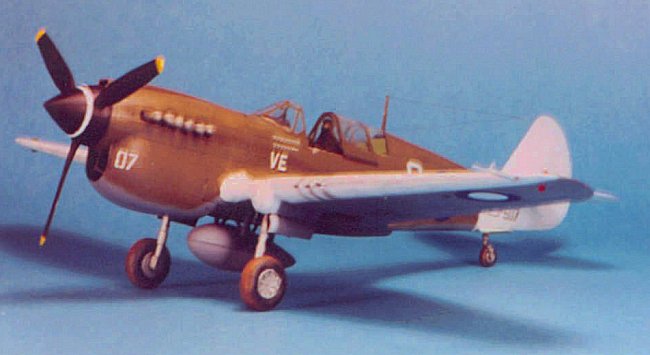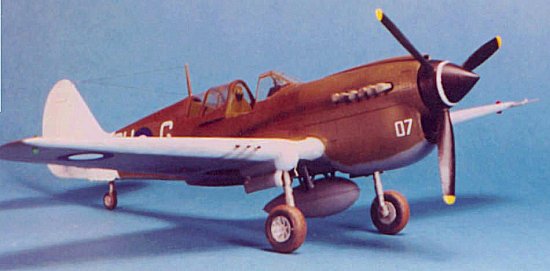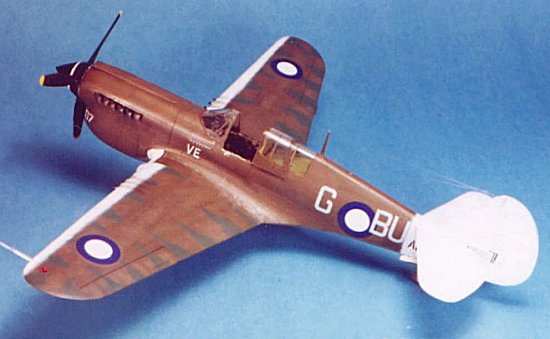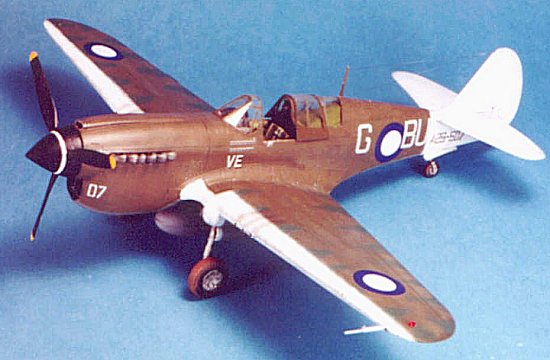
|
KIT: |
Eduard 1/48 P-40N Warhawk |
|
KIT # |
8036 |
|
PRICE: |
$29.98 |
|
DECALS: |
See review |
|
REVIEW & |
|
|
NOTES: |
Red-Roo decals # 48-02 |

|
HISTORY |
The Curtiss P-40 has been damned and praised in about equal verbiage. At the time the United States entered the Second World War, it was the standard USAAF fighter. As with the Bell P-39, the P-40 had been effectively neutered by the Air Force decision that the new generation of fighters these aircraft represented did not need supercharging for high altitude performance. As a result, the airplane was at the disadvantage in combat over 12,000 feet. It also suffered from the fact that it was the end of a Curtiss design cycle that had begun with the P-36 Hawk. The P-40 had added weight, and trailed behind the cutting edge of aeronautical development at the time it most needed to be new. However, as the first American single-seat fighter to be manufactured on a mass-production basis, it bore the brunt of air combat during the first part of the war. While its performance was inferior to almost every opponent it faced, this was partially compensated for by its tractability and sturdiness, which allowed it to suffer punishment and still get home. Most importantly, it was available when most needed.
 The P-40 was provided in large numbers to every Allied nation with an air
force through Lend-Lease until it ceased production in late 1944. It was an
important combat type on the Eastern Front, North Africa, and the Pacific
Theater where it was flown by the USAAF, RAAF and RNZAF.
The P-40 was provided in large numbers to every Allied nation with an air
force through Lend-Lease until it ceased production in late 1944. It was an
important combat type on the Eastern Front, North Africa, and the Pacific
Theater where it was flown by the USAAF, RAAF and RNZAF.
The most important production version was the P-40N, which appeared in 1943 and attempted to bring down weight and improve performance; with a top speed of 378 m.p.h. it was the fastest of all P-40 variants. The N was distinguishable from the others by the changes in the canopy, with a frameless hood and rectangular aft section to improve rearward view.
The P-40 in the RAAF:
The RAAF first became familiar with the Curtiss P-40 in the Western Desert of North Africa, where several RAAF squadrons flew combat in the earlier Tomahawk, and in the Kittyhawk variants as they entered operational service. Several top-scoring RAAF pilots flew the P-40, including Clive Caldwell and John Waddy.
When the Japanese attacked in December 1941, the RAAF was woefully short of useful combat aircraft of any type, and was greatful to get the Kittyhawk Ia, which was the British version of the P-40E. These went into combat over New Guinea in 1942.
By 1944, the South West Pacific Area (SWPA) was rapidly becoming a backwater of the Pacific War, with the main action moving north with the U.S. Navy's Central Pacific Offensive and General MacArthur's return to the Philippines. The RAAF was committed to operations in the Netherlands East Indies region, due to Australian post-war interests centering on this area. 80 Wing in P-40s was used to escort Beaufighter raids and also to conduct their own fighter-bomber raids from Noemfoor Island. The commander of the wing at this time was John Waddy, who had returned from his tour in North Africa with a score of 15, all in P-40s, which made him the top-scoring Australian P-40 pilot of the war.
|
THE KIT |
In 1994, Mauve produced the P-40N and Kittyhawk III (P-40M), which were the best P-40 kits produced to that time, with good quality molding the equal of Hasegawa's P-51. The only failing was the cockpit, and that was easily remedied through the use of the True Details resin cockpit for the P-40E-N. Following the earthquake in Kobe-Osaka, Mauve went out of production in Japan. Eventually the molds were purchased by Eduard of the Czech Republic, and the P-40N was released in 1999 with a resin cockpit and photo-etch detail fret.
 New Decals:
New Decals:
During the time that Mauve had the kit in production, both Aeromaster and SuperScale released decals for both versions, including an Aeromaster sheet that had the markings for Waddy's P-40N. However, the research was inaccurate, with the Australian P-40s assumed to have been repainted in Forest Green and Sky, which was not the case. More recent research by Red Roo in Australia has brought out the fact that the P-40Ns were supplied in the American scheme of Olive Drab 41 over Neutral Grey, some with Medium Green blotches on the leading and trailing edges of the horizontal surfaces, and with US markings that were overpainted in those positions by the RAAF roundels. Additionally, the white theater markings were not as neatly applied as originally thought, with the white tails and wing leading edges being sprayed freehand in the field. Fortunately, Red Roo has recently released a series of decals for various RAAF P-40Ns, with this markings information. One of those was for Waddy's two aircraft. For this model, I chose to do the earlier and better-known of the two.
|
CONSTRUCTION |
Construction starts with the cockpit. I painted the resin parts interior green, and when they were dry sprayed a black wash over them to pop out the detail. I then dry brushed Testor's Model Master Aluminum over the various parts to "weather" them and bring out more detail. The cockpit was then assembled and inserted in the already-assembled fuselage. The wings went together easily, and were glued to the fuselage, as were the horizontal stabilizer.
The one hard part of this model is the rear glass area. For some odd reason, Mauve chose to make a glass part that is larger than the glass area; the part does not match to the fuselage by any panel lines, and is not a close fit either. You have to putty the joint and then file and sand it to get ride of the seam. Doing this without also ruining the glass area is hard. However, if you do manage a few scratches of the glass area, the easy solution is to paint a nice thick coat of Future over the external surface after you have sanded the scratched area as smooth as possible. The Future will cover the scrach and the "fogged" area, returning it to the clear look it should have.
Painting:
I decided to paint this model the way the original had been. I painted the lower surface with Tamiya Neutral Gray, the upper surfaces with Gunze-Sanyo Olive Drab 41, which I lightened with a bit of white and then went back over the area to simulate sun facing, then blotched the wings and horizontal stabilizer with Gunze Green FS34092. I then freehanded the leading edges and tail with Tamiya Flat White, thinning it down enough that I would not get a lot of overspray, and would also result in a "ragged" look in which you can see the underlying darker colors.
|
PAINT & DECALS |
 Decals:
Decals:
The Red Roo decals are very thin, but not so much that they cause trouble with curling and folding. They are not so sticky they cannot be moved around to position them, and go down nicely under a coat of Micro-Sol.
Final Assembly:
The landing gear is quite detailed, though I think the tailwheel leg is too short. I lengthened this with a piece of Evergreen tubing. Many modelers have expressed fear that the kit wheels for the P-40N are wrong because they are too small for the wheel wells. In fact, these wheels are right: as part of the weight reduction program on the P-40N, wheels for the P-51 were substituted for the standard P-40 wheels which were larger and heavier. The wheel well, however, was unmodified. (Trust me on this, I have seen it on the three P-40Ns out at Chino.) I used the Squadron vacuform P-40N canopy for the frameless hood and windshield.
|
CONCLUSIONS |
The Mauve/Eduard P-40 is an accurate model, and the best P-40 kit currently available. With the additional detail of a resin cockpit it makes up into a very credible representation of the airplane that was called "the best second choice of the war."
If you would like your product reviewed fairly and quickly by a site that has over 1,500 visits a day, please contact me or see other details in the Note to Contributors.